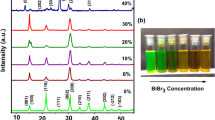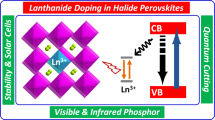Abstract
In this study, the optoelectronic characteristics of cesium-based all-inorganic perovskite (AIP) nanocrystals (NCs) are examined in relation to Sr/Ni doping. These nanocrystals are synthesized via the hot injection method and then examined for compositional, morphological, optical, and electrical characteristics. Scanning electron microscopy reveals the homogeneous and compact NCs clusters while Atomic Force Microscopy (AFM) studies shows smooth film morphology with a narrow size distribution. X-ray diffraction analysis confirmed the monoclinic perovskite structure and excellent crystallinity. Similarly, Fourier-transform infrared spectroscopy has shown evidence for the existence of long-chain organic ligands employed for the stability and passivation of the NCs. High absorbance in the visible region is seen by UV–Visible spectroscopy, with a band gap of 2.44–2.48 eV while steady-state photoluminescence spectroscopy indicates low lattice defects and high crystallinity. Doping with Sr/Ni increased the bulk charge carrier concentration up to 3.70 × 1016 cm−3 and decreased the resistivity to 4.61 × 103 Ω cm as compared to 1.45 × 1013 cm−3 and 8.58 × 103 Ω cm respectively according to measurements made using the hall effect measurments. The doped AIP NCs displayed excellent thermal stability up to 545 °C. The Ni/Sr doping has resulted in obtaining improved properties in CsPbBr3 perovskite NCs for optoelectronic application.
Graphical Abstract






Similar content being viewed by others
References
X. Ling, J. Yuan, W. Ma, The rise of colloidal lead halide perovskite quantum dot solar cells. Acc. Mater. Res. (2022). https://doi.org/10.1021/accountsmr.2c00081
B. Yu, S. Tan, D. Li, Q. Meng, The stability of inorganic perovskite solar cells : from materials to devices. Mater. Fut. 2, 032101 (2023)
Y. Tong et al., Highly luminescent Cesium lead halide perovskite nanocrystals with tunable composition and thickness by ultrasonication. Angew. Chemie Int. Ed. 55(44), 13887–13892 (2016). https://doi.org/10.1002/anie.201605909
R. Fukamizu, N. Aso, Y. Shiratori, S. Miyajima, Nanocrystalline gallium nitride electron transport layer for cesium lead bromide photovoltaic power converter in blue light optical wireless power transmission. Jpn. J. Appl. Phys.. J. Appl. Phys. 62, SK1035 (2023)
M. Palabathuni, S. Akhil, R. Singh, N. Mishra, Charge transfer in photoexcited cesium-lead halide perovskite nanocrystals: review of materials and applications. ACS Appl. Nano Mater. (2022). https://doi.org/10.1021/acsanm.2c01550
A. Raman, C. Chaturvedi, N. Kumar, Multi-quantum well-based solar Cell, in Electrical and electronic devices, circuits, and materials. ed. by S.L. Tripathi, P.A. Alvi, U. Subramaniam (Wiley, New York, 2021), pp.351–372. https://doi.org/10.1002/9781119755104.ch19
N. Gandhi et al., Gate Oxide Induced Reliability Assessment of Junctionless FinFET-based hydrogen gas sensor, in Proceedings of the IEEE Sensors, no. c, pp. 1–4 (2023). https://doi.org/10.1109/SENSORS56945.2023.10324885.
Y. Kanemitsu, Halide perovskite nanocrystals: unique luminescence materials. J. Lumin.Lumin. 251, 119207 (2022). https://doi.org/10.1016/j.jlumin.2022.119207
K. Kano, Y. Iso, Effects of perfluorodecanoic acid on the photostability and self-recovery of cesium lead bromide nanocrystals effects of per fluorodecanoic acid on the photostability and self-recovery of cesium lead bromide nanocrystals. ECS J. Solid State Sci. Technol. 12, 056003 (2023). https://doi.org/10.1149/2162-8777/acd214
J.M. Luther, A. Swarnkar, A.R. Marshall, E.M. Sanehira, B.D. Chernomordik, D.T. Moore, J.A. Christians, T. Chakrabarti, Quantum dot–induced phase stabilization of a-CsPbI3 perovskite for high-efficiency photovoltaics. Science (80-) 354(6308), 92–95 (2016). https://doi.org/10.1126/science.aag2700
E.M. Sanehira et al., Enhanced mobility CsPbI3 quantum dot arrays for record-efficiency, high-voltage photovoltaic cells. Sci. Adv. (2017). https://doi.org/10.1126/sciadv.aao4204
Z. Zhang et al., Significant improvement in the performance of PbSe quantum dot solar cell by introducing a CsPbBr3 perovskite colloidal nanocrystal back layer. Adv. Energy Mater. (2017). https://doi.org/10.1002/aenm.201601773
M.A. Basit, M. Rashid, T.F. Khan, M. Muhyuddin, S. Butt, Simplistic thermal transformation of MIL-125 to TiO2 nano-coins and nano-diamonds for efficient quantum-dot sensitized solar cells. Mater. Sci. Semicond. Process.Semicond. Process. 104, 104663 (2019). https://doi.org/10.1016/j.mssp.2019.104663
H.M. Naeem et al., HF-based surface modification for enhanced photobiological and photochemical performance of ZnO and ZnO/CdS hierarchical structures. Mater. Chem. Phys. 252, 123190 (2020). https://doi.org/10.1016/j.matchemphys.2020.123190
Liming Ding, C. Yi, M. Li, Ch 5, 5.1 Basic concepts and principles of doping 5.2 Applications of Doping and Alloying in Perovskite (2022), ISBN: 978-3-527-34924-1, Wiley-VCH
H. Cheng, Y. Feng, Y. Fu, Y. Zheng, Y. Shao, Y. Bai, Understanding and minimizing non-radiative recombination losses in perovskite light-emitting diodes. J. Mater. Chem. C (2022). https://doi.org/10.1039/d2tc01869a
M.A. Padhiar et al., Sr2+ doped CsPbBrI2 perovskite nanocrystals coated with ZrO2 for applications as white LEDs. Nanotechnology 34(27), 275201 (2023). https://doi.org/10.1088/1361-6528/acc9cc
N. Mireles Villegas, J.C. Hernandez, J.C. John, M. Sheldon, Promoting solution-phase superlattices of CsPbBr3 nanocrystals. Nanoscale 15(22), 9728–9737 (2023). https://doi.org/10.1039/d3nr00693j
S.J.F. Byrnes, Basic theory and phenomenology of polarons. pp. 2–6 (2008), Department of Physics, University of California at Berkeley, Berkeley, CA 94720 December 2, 2008. https://sjbyrnes.com/FinalPaper--Polarons.pdf
Y. Yamada, Y. Kanemitsu, Electron-phonon interactions in halide perovskites. NPG Asia Mater. (2022). https://doi.org/10.1038/s41427-022-00394-4
W. Tao, Y. Zhang, H. Zhu, Dynamic exciton polaron in two-dimensional lead halide perovskites and implications for optoelectronic applications. Acc. Chem. Res. 55(3), 345–353 (2022). https://doi.org/10.1021/acs.accounts.1c00626
M. Sajedi et al., Is there a polaron signature in angle-resolved photoemission of CsPbBr3? Phys. Rev. Lett. 128(17), 176405 (2022). https://doi.org/10.1103/PhysRevLett.128.176405
“The Hall Effect 1 Background., the Washington University online course data, available at https://courses.washington.edu/phys431/hall_effect/hall_effect.pdf
S. Li et al., Sodium doping-enhanced emission efficiency and stability of CsPbBr3 nanocrystals for white light-emitting devices. Chem. Mater. 31(11), 3917–3928 (2019). https://doi.org/10.1021/acs.chemmater.8b05362
Y. Cao, D. Wu, P. Zhu, D. Shan, X. Zeng, J. Xu, Down-shifting and anti-reflection effect of cspbbr3 quantum dots/multicrystalline silicon hybrid structures for enhanced photovoltaic properties. Nanomaterials 10(4), 775 (2020). https://doi.org/10.3390/nano10040775
M.C. Wu, W.C. Chen, S.H. Chan, W.F. Su, The effect of strontium and barium doping on perovskite-structured energy materials for photovoltaic applications. Appl. Surf. Sci. 429, 9–15 (2018). https://doi.org/10.1016/j.apsusc.2017.08.131
M. Asemi, M. Ghanaatshoar, Hydrothermal growth of one-dimensional Ce-doped TiO2 nanostructures for solid-state DSSCs comprising Mg-doped CuCrO2. J. Mater. Sci. 52(1), 489–503 (2017). https://doi.org/10.1007/s10853-016-0348-z
A. Saqib, J. Sofia, A. Muhammad, U. Muhammad, A.A. Muhammad, Synthesis and characterization of CsPbBr3 for perovskite solar cells. Key Eng. Mater. (KEM) 875, 3–9 (2021). https://doi.org/10.4028/www.scientific.net/KEM.875.3
P. Singh, A. Raman, N. Kumar, Spectroscopic and simulation analysis of facile PEDOT:PSS layer deposition-silicon for perovskite solar cell. SILICON 12(8), 1769–1777 (2020). https://doi.org/10.1007/s12633-019-00284-5
V.R. Yandri, P. Wulandari, R. Hidayat, Photoluminescence properties of CsPbCl3 and CsPbBr3 nanocrystals synthesized by LARP method with various ligands and anti-solvents. J. Phys. Conf. Ser. 2243(1), 5 (2022). https://doi.org/10.1088/1742-6596/2243/1/012120
S.M.H. Qaid, H.M. Ghaithan, A.S. Aldwayyan, Investigation of the amplified spontaneous emission threshold of cesium lead bromide perovskite quantum dots at different excitation wavelengths. ECS J. Solid State Sci. Technol. 12(5), 055012 (2023). https://doi.org/10.1149/2162-8777/acd6bc
A. Sutar, S. Balwadkar, S. Doke, A. Shinde, S. Kulkarni, S. Kahane, Enhancement in photoluminescence of nematic liquid crystals doped with CsPbBr3 quantum dots. J. Phys. Conf. Ser. 2426(1), 012049 (2023). https://doi.org/10.1088/1742-6596/2426/1/012049
A. Nawaz et al., Insights into optoelectronic properties of anti-solvent treated perovskite films. Artic. J. Mater. Sci. Mater. Electron. 28, 15630–15636 (2017). https://doi.org/10.1007/s10854-017-7451-z
J. Li et al., CsPbBr3 perovskite quantum dots: saturable absorption properties and passively Q-switched visible lasers. Photon. Res. 5(5), 457 (2017). https://doi.org/10.1364/prj.5.000457
N. Aso, H. Tani, R. Fukamizu, H. Shimizu, S. Miyajima, Improvement of carrier transport properties of CsPbBr3 thin films by moisture absorption and TbCl3 doping technique. Jpn. J. Appl. Phys.. J. Appl. Phys. 62, 1 (2023). https://doi.org/10.35848/1347-4065/acd38d
Z. Yang et al., Engineering the exciton dissociation in quantum-confined 2D CsPbBr3 nanosheet films. Adv. Funct. Mater.Funct. Mater. 28(14), 1705908 (2018). https://doi.org/10.1002/adfm.201705908
Q. Wang et al., Qualifying composition dependent p and n self-doping in CH3NH3PbI3. Appl. Phys. Lett. 105(16), 3–9 (2014). https://doi.org/10.1063/1.4899051
B. Ebenhoch, S.A.J. Thomson, K. Genevičius, G. Juška, I.D.W. Samuel, Charge carrier mobility of the organic photovoltaic materials PTB7 and PC71BM and its influence on device performance. Org. Electron. 22, 62–68 (2015). https://doi.org/10.1016/j.orgel.2015.03.013
A. Shaheen, W. Zia, M.S. Anwar, Band structure and electrical conductivity in semiconductors, 2010. Accessed: Jul. 05, 2020 (online). Available: http://www.inst.eecs.berkeley.edu.
J.B. Hoffman, G. Zaiats, I. Wappes, P.V. Kamat, CsPbBr3 Solar cells: controlled film growth through layer-by-layer quantum dot deposition. Chem. Mater. (2017). https://doi.org/10.1021/acs.chemmater.7b03751
Author information
Authors and Affiliations
Corresponding author
Ethics declarations
Conflict of interest
The authors declare that they have no known competing financial interests or personal relationships that could have appeared to influence the work reported in this paper.
Ethical Approval
This work has not been published previously and is not under consideration for publication elsewhere. It is further added that the manuscript is approved by all authors and if accepted, it will not be published elsewhere in the same form, in English or any other language, without the written consent of the Publisher. All authors help shape the research and provided critical feedback, approved the final version of the manuscript.
Additional information
Publisher's Note
Springer Nature remains neutral with regard to jurisdictional claims in published maps and institutional affiliations.
Supplementary Information
Below is the link to the electronic supplementary material.
Rights and permissions
Springer Nature or its licensor (e.g. a society or other partner) holds exclusive rights to this article under a publishing agreement with the author(s) or other rightsholder(s); author self-archiving of the accepted manuscript version of this article is solely governed by the terms of such publishing agreement and applicable law.
About this article
Cite this article
Ali, S., Javed, S., Akram, M.A. et al. Investigating the Electrical and Optical Properties of Nickle and Strontium Co-Doped CsPbBr3 Nanocrystals: Potential Absorber Material for Perovskite Solar Cells. Trans. Electr. Electron. Mater. (2024). https://doi.org/10.1007/s42341-024-00520-9
Received:
Revised:
Accepted:
Published:
DOI: https://doi.org/10.1007/s42341-024-00520-9




